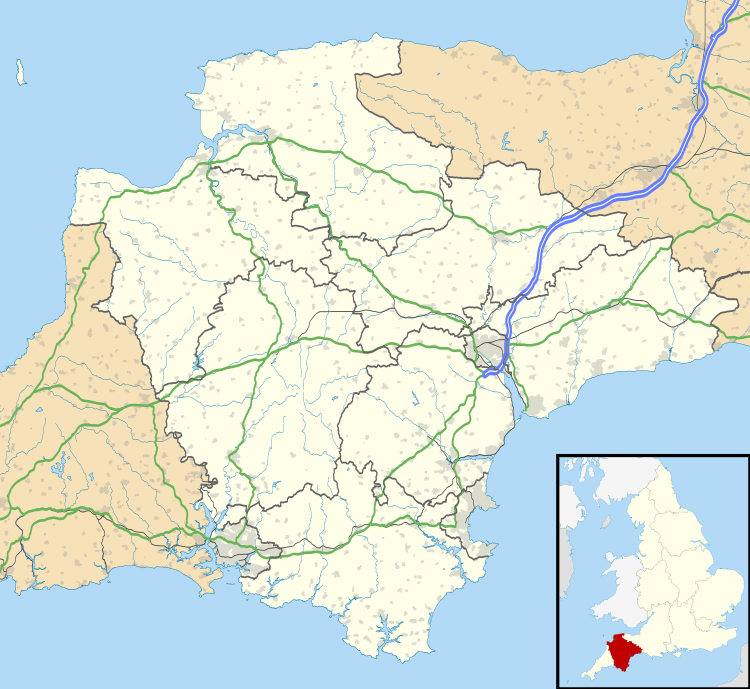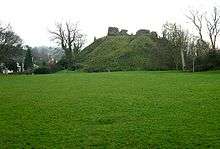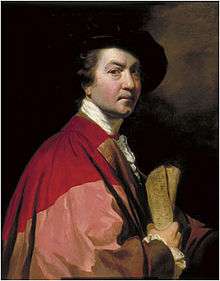Plympton
| Plympton | |
 Looking down on part of the town from the castle |
|
 Plympton |
|
| Population | 29,899 (2011 Census) |
|---|---|
| OS grid reference | SX542561 |
| Shire county | Devon |
| Region | South West |
| Country | England |
| Sovereign state | United Kingdom |
| Post town | PLYMOUTH |
| Postcode district | PL7 |
| Dialling code | 01752 |
| Police | Devon and Cornwall |
| Fire | Devon and Somerset |
| Ambulance | South Western |
| EU Parliament | South West England |
| UK Parliament | South West Devon |
Coordinates: 50°23′10″N 4°03′04″W / 50.386°N 4.051°W
Plympton, or Plympton Maurice or Plympton St Maurice or Plympton St Mary or Plympton Erle, in south-western Devon, is a populous, north-eastern suburb of the city of Plymouth of which it officially became part, along with Plymstock, in 1967. It was an ancient stannary town: an important trading centre in the past for locally mined tin, and a former seaport (before the River Plym silted up and trade moved down the river to Plymouth).
Plympton still has its own town centre (called the Ridgeway), and is itself an amalgamation of several villages, including St Mary's, St Maurice, Colebrook, Woodford, Newnham, Langage and Chaddlewood.
Toponymy
Although the name of the town appears to be derived from its location on the River Plym (compare, for instance, Otterton or Yealmpton), this is not considered to be the case. As J. Brooking Rowe pointed out in 1906, the town is not and never was sited on the river.[1] The earliest surviving documentary reference to the place is as Plymentun in Anglo-Saxon charter S380 dated to around 900 AD,[2] and this name may be derived from the Old English adjective plymen, meaning "growing with plum-trees". So Plympton would have the meaning "Plum-tree farm".[3] The local civic association, however, suggests an alternative derivation from the Celtic Pen-lyn-dun ("fort at the head of a creek").[4] Alternatively, Cornish derivations also give ploumenn meaning 'plum' and plo(b)m meaning 'lead' - possibly related to Latin plombum album ( 'British lead') or tin.[5]
By the early 13th century, the River Plym was named from a back-formation from this name and nearby Plymstock.[3] This later led to the naming of the fishing port created at the river's mouth (Plymouth, originally named Sutton) when the river estuary silted up too much for the monks to sail up river to Plympton any longer.
History
Near Plympton is the Iron Age hill fort of Boringdon Camp.
Domesday Book
Plympton is listed in the Domesday Book of 1086 as follows:
”The King holds Plympton. TRE[6] it paid geld for two and a half hides. There is land for 20 ploughs. In demesne are two ploughs and six slaves and 5 villans and 12 bordars with 12 ploughs. There are 6 acres (24,000 m2) of meadow and 20 acres (81,000 m2) of pasture, woodland one league long and a half broad. It renders £13 10s by weight. Beside this land the canons of the same manor hold 2 hides. There is land for 6 ploughs. There 12 v have 4 ploughs. It is worth 35 shillings.[7]
Note: Domesday book measurements are informed best guess only. This is due to the outdated measurements not being truly translatable to those in modern use. They are, as stated in the source, a transliteration rather than original.
Plympton Priory
Plympton was the site of an important priory founded by William Warelwast in the early 12th century. The members were Augustinian canons and the priory soon became the second richest monastic house in Devon (after Tavistock). The gatehouse of the priory is still in existence. In 1872 it was recorded that the gatehouse, kitchen and refectory were still in good condition.[8]
Plympton Castle

Richard de Redvers (d.1107) was granted the feudal barony of Plympton, with caput at Plympton Castle, by King Henry I (1100-1135), of which king he was a most trusted supporter. His family later became Earls of Devon. Their lands, including Plympton, and titles were later inherited by the Courtenay family, feudal barons of Okehampton. The ancient Stannary town remains dominated by its now ruined Norman motte-and-bailey castle and it still retains a cohesive medieval street pattern. A number of historic buildings in the local vernacular style of green Devon slate, limestone and lime-washed walls, with Dartmoor granite detailing, attest to all periods of its history.
Rotten Borough
The town was one of the rotten boroughs, and sent two MPs to the unreformed House of Commons before the Reform Act 1832 stripped it of its representation.
Birthplace of Joshua Reynolds

The town was the birthplace and early residence of the painter Sir Joshua Reynolds. Reynolds was Mayor of Plympton, as well as first president of the Royal Academy of Art. His father was headmaster of Plympton Grammar School which itself is an attractive historic building in the centre of the town. Former pupils were Benjamin Haydon and Sir Charles Lock Eastlake, PRA, who were respectively first director of the National Gallery and first president of the Royal Photographic Society. Many of Reynold's paintings were purchased by his friends the Parker family of local Saltram House, now owned by the National Trust, and are still on public display there.
Historic estates
The present parish encompasses the historic former parishes:
- Plympton St Maurice
- Colebrook, in which is the manor of Boringdon, a seat of the Parker family formerly of North Molton, which later acquired Saltram. Adjacent is the Iron-Age hill-fort Boringdon Camp.
- Woodford
- Plympton St Mary, which contains:
- Loughtor (after c.1718 renamed Newnham Park), the seat of William II Selman, 5 times MP for Plympton Erle between 1420 and 1429. The lords of the borough of Plympton Erle were the Courtenays, with whom Selman must therefore have had a connection. [9] It was later a minor seat of a cadet branch of the Courtenay family, feudal barons of Plympton and Okehampton and Earls of Devon which was the inheritance of a younger son, Sir Philip Courtenay of Molland (d.1488), MP, Sheriff of Devon in 1470–71. He was the second son of Sir Philip Courtenay (died 1463) of Powderham (a descendant of Hugh Courtenay, 2nd Earl of Devon (d.1377) by his wife Elizabeth Hungerford. He was given by his parents the Hungerford manor of Molland and established there his own branch of the family. He married Elizabeth (d.1482), whose parentage is not recorded in surviving records, the widow of William Hyndeston of Wonwall[10] in the parish of Kingston, Devon. Sir Philip's 3rd son was William Courtenay of Loughtor, whose son Sir Philip Courtenay of Loughtor died without issue.[10] The effigy of William Courtenay of Loughtor exists in Plympton St Mary Church, south chancel aisle.[11] Sir Philip Courtenay of Molland's second son and William's brother, was Philip Courtenay who married Jane Fowell, daughter of Richard Fowell of Fowelscombe.[12] Their only daughter and the heiress of Loughtor was Elizabeth Courtenay, who married her neighbour William Strode (d.1579) of Newnham, Plympton St Mary.[13] Loughtor thus descended into the Strode family, which in the late 18th century abandoned its old adjoining seat of Newnham, with its mediaeval house, to build a new principal seat at Loughtor called Newnham Park. Loughtor was also the seat of the Selman family, members of which were several times Members of Parliament for Plympton Erle.
- Newnham, which manor was long the seat of the Strode family,[14] whose monuments exist in Plympton St Mary's Church, including the tomb-chest of Richard Strode (d.1464), the effigy of which is clad in armour. The monument of William II Strode (d.1637) and his family shows husband, two wives and ten children. The monument to his daughter Ursula Strode, the wife of Sir John III Chichester of Hall, exists in Bishop's Tawton Church. A notable member of this family and William II Strode's second son was the parliamentarian Sir William Strode (1594–1645), one of the Five Members whom King Charles I attempted to arrest in the House of Commons in 1642. The descent of the family is as follows:[15]
- Richard I Strode (d.1464), married Margaret Fortescue, daughter of Henry Fortescue of Wood. His eldest son William Strode (d.1518) died without progeny.
- Richard II Strode (2nd son), married Joan Pennalls, daughter of Ellis Pennalls of Plympton.
- Richard III Strode (d.1552) (son), married Agnes Milliton, daughter of John Milliton of Meavy.
- William I Strode (d.1579) (son), married Elizabeth Courtenay, daughter of Philip Courtenay, a younger son of Sir Philip Courtenay (d.1488) of Molland.[16]
- Richard IV Strode (d.1581) (son), married Frances Cromwell.
- William II Strode (d.1637) (son), MP
- Richard V Strode (d.1669) (son), MP
- William III Strode (d.1676) (son), MP
- Newnham, which manor was long the seat of the Strode family,[14] whose monuments exist in Plympton St Mary's Church, including the tomb-chest of Richard Strode (d.1464), the effigy of which is clad in armour. The monument of William II Strode (d.1637) and his family shows husband, two wives and ten children. The monument to his daughter Ursula Strode, the wife of Sir John III Chichester of Hall, exists in Bishop's Tawton Church. A notable member of this family and William II Strode's second son was the parliamentarian Sir William Strode (1594–1645), one of the Five Members whom King Charles I attempted to arrest in the House of Commons in 1642. The descent of the family is as follows:[15]
- Langage
- Chaddlewood
Railway
Railway facilities were originally provided at Plympton—for goods traffic only—by the horse-drawn Plymouth and Dartmoor Railway, but their branch was closed and sold to the South Devon Railway to allow them to build a line from Exeter to Plymouth. A station was opened in the town on 15 June 1848. From 1 June 1904 it was the eastern terminus for enhanced Plymouth area suburban services but it was closed from 3 March 1959.
Churches
St Maurice
The churches are St Maurice (or rather the Church of St Thomas at Plympton St Maurice) of Norman origin.The only remarkable feature is the tower which was rebuilt in the middle of the 15th century.
St Mary
St Mary's church was dedicated in 1311 and was originally a parish chapel attached to Plympton Priory and is a church of more importance.It has two aisles on each side of the nave,the outer aisles being shorter than the inner ones.The lofty tower is of granite ashlar and visible from afar.The south porch is ornamented with carving and has a lierne vault. The outer north aisle is the earliest part of the church and the rest is mainly of the 15th century, the south aisle being the latest part.There are interesting monuments to the family of Strode, including a tomb-chest for Richard Strode (d.1464),the effigy being clad in armour.The monument of William Strode (d. 1637)and his family shows husband,two wives and ten children.There is also a monument of W.Seymour (d. 1801) in Coade stone and of Viscount Boringdon, the 11-year-old heir to the Earl of Morley of Saltram House who died in Paris in 1817,by François-Nicolas Delaistre.
Modern Plympton
Between about 1990 and 2010 Plympton has seen considerable growth as the suburban population of Plymouth has doubled. To help manage this rapid growth more efficiently, Plympton has been separated into a series of separate districts: Yealmpstone, Plympton-St Maurice, Colebrook, Underwood, Woodford and Chaddlewood.
Schools
Plympton has two state secondary schools serving pupils from ages 11–18. Both Ridgeway School and Hele's School attract students from the Plympton area and surrounding areas of Laira, Ivybridge and Dartmoor.
New Town proposal
A new town to be called Sherford is proposed to be built adjacent to Plympton. This development is expected to consist of "at least 4,000 dwellings by 2016".[17]
Public transport
Plympton has four main bus services: routes 20, 20a, 21 and 21a.
The Plym Valley Railway is a preserved railway based at the reconstructed Marsh Mills station on Coypool Road. This was formerly part of the GWR Plymouth to Launceston branch line. The volunteer-run PVR is actively rebuilding the line between Marsh Mills and Plymbridge. Steam and diesel heritage trains run on numerous Sundays throughout the year.
Plymouth City Council has stated it would like to see a rail station reopened on the London main line running through the middle of Plympton, which would provide quick and frequent trains into Plymouth. But there are major obstacles to providing such a service on a primarily inter-regional rail route, shown when Ivybridge - on the same line - got a new station in 1994.
Notable residents
- Elizabeth Johnson, religious pamphleteer, born in Plympton in 1721.
- Ellen Marriage, pioneer Balzac translator, and her husband Edmund Garrett, an Ibsen translator, lived here up to Garrett's death in 1907.[18]
- David Owen, former Foreign Secretary, born in Plympton
- Sir Joshua Reynolds, painter, born in Plympton
- Sir Edwin Sandys, founded the colony of Jamestown, was an MP for Plympton
- Richard Strode, MP for Plympton, established Parliamentary privilege
- William Warelwast, buried here (in the priory)
- Paul Rogers, actor, born in Plympton
See also
References
- ↑ J. Brooking Rowe (1906). "A History of the Borough of Plympton Erle: the Castle and Manor of Plympton... (Internet Archive)". James G. Commin, Exeter. p. 5. Retrieved 2011-04-04.
- ↑ "Anglo-Saxon Charters". ascharters.net. Retrieved 2011-04-04.
- 1 2 Watts, Victor (2010). The Cambridge Dictionary of English Place-names (1st paperback ed.). Cambridge University Press. pp. 475–6. ISBN 978-0-521-16855-7.
- ↑ "Plympton Castle". Plympton St Maurice Civic Association. Retrieved 2012-12-02.
- ↑ The ancient language and the dialect of Cornwall , Fred W.P.Jago, 1882, Truro
- ↑ TRE in Latin is Tempore Regis Edwardi, i.e. "in the time of King Edward the Confessor" before the Battle of Hastings
- ↑ Domesday Book: a complete transliteration. London: Penguin, 2003. ISBN 0-14-143994-7 p.279
- ↑ Pevsner, N. (1952) South Devon. Harmondsworth: Penguin Books; pp. 242–45
- ↑ "SELMAN, William II, of Loughtor in Plympton St. Mary, Devon. | History of Parliament Online". www.historyofparliamentonline.org. Retrieved 2016-09-02.
- 1 2 Vivian, Heraldic Visitations of Devon, p.246, pedigree of Courtenay of Molland
- ↑ Pevsner & Cherry, Buildings of England: Devon, 2004, p.685
- ↑ Vivian, Heraldic Visitations of Deon, p.369, pedigree of Fowell
- ↑ Vivian, Heraldic Visitations of Deon, p.718, pedigree of Strode
- ↑ Vivian, Heralds' Visitations of Devon, 1895, pp.718–20, pedigree of Strode
- ↑ Vivian, Heralds' Visitations of Devon, 1895, pp.718–19
- ↑ Vivian, Heralds' Visitations of Devon, 1895, p.251 & 718
- ↑ Sherford Area Action Plan (August 2007), p.5, section 1.14
- ↑ Margaret Lesser: Marriage, Ellen (1865–1946). In: Oxford Dictionary of National Biography (Oxford: Oxford University Press, May 2010). Subscription required. Retrieved 23 August 2010.
External links
| Wikimedia Commons has media related to Plympton. |